Dialogue with the Chief Lumada Business Officer
Nikkei Business Online Edition: September 2021 Special Feature

For many years, Hitachi, Ltd. (hereinafter Hitachi) has been providing the systems that support social infrastructure, including infrastructure for electric power, railways, telecommunications, and water and sewer services. Hitachi promotes its social innovation business through the high-level fusion of digital technologies with the knowledge and expertise it has cultivated in various businesses. By resolving social issues and business management issues, Hitachi aims to achieve sustainable growth. Playing an important role in this effort is Lumada: a collection of solutions, services, and technologies that utilize Hitachi’s cutting-edge digital technologies to collaboratively create new value. Social Infrastructure Systems Business Unit CLBO & COO Yoshinori Hosoya talked with Hitachi newcomers Yoshimitsu Kaji and Madoka Sawa about the overall vision of this effort and about Lumada.
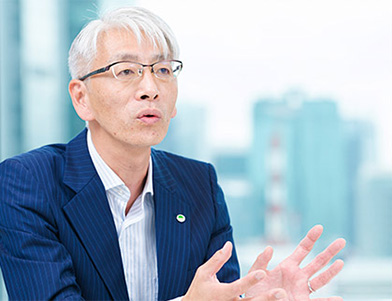
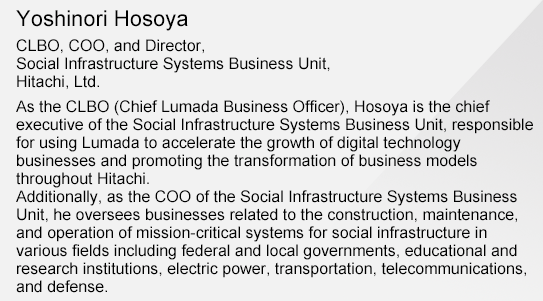
―In recent years, people have been calling for the use of digital technologies to resolve social issues. From an early stage in this movement, Hitachi has been actively promoting the digital transformation of social infrastructure as part of its social innovation business. First, please tell us about the background and the reasons why the digital transformation of social infrastructure is even necessary.
Hosoya: Society is at an important turning point. COVID-19 has dealt a blow to the global economy, exacerbating economic inequality. At the same time, concern over environmental issues is on the rise, and global initiatives are now underway.
The problem is that these changes continue to accelerate. For example, I think everyone is aware of the spate of heatwaves, floods, droughts, and other disasters that have been occurring all over the world and are attributed to climate change.
With respect to the economy, too, globalization continues to spread. In Japan, where we have a decreasing birthrate and aging population, it is crucial that we consider how to balance the environment and the economy and how to build a sustainable society.
Who knows? We might be the last generation that can resolve the social issues occurring on a global scale. For that reason, we need new approaches, not just makeshift solutions or extensions of existing approaches. What we need is none other than the digital transformation of social infrastructure—the resolution of social issues through the power of digital technologies.
Kaji: Reducing the impact on the environment, redistributing wealth, and building safe and secure societies—we cannot afford to put off resolving these social issues.
The late Hiroaki Nakanishi, who previously served as President and Chairman of Hitachi, pushed forward with a new growth strategy from 2020 as the chairman of Keidanren (the Japan Business Federation). This new strategy exemplified Nakanishi’s idea of what sustainable capitalism should be. The direction of Keidanren’s goal and the path to resolving social issues that Mr. Hosoya mentioned just now are the same from the perspective of the SDGs (sustainable development goals) and also go hand-in-hand with the aim of Hitachi’s social innovation business.
As counselor of the Cabinet Secretariat’s international relations office, I was previously involved in various initiatives related to the Great East Japan Earthquake. At the time, Japan had been working on the MDGs (Millennium Development Goals), which aimed to resolve global development issues. However, it eventually became apparent that the MDGs were no longer sufficient, so the SDGs were adopted at the United Nations’ 2015 summit. In 2009, prior to the summit, Hitachi had already declared its shift to the social innovation business, which combines the social infrastructure technologies and IT that Hitachi has cultivated over many years. The foresight shown by this declaration was quite impressive.
Sawa: With its technologies and solutions for a wide range of industrial fields, Hitachi as a group is working on the social innovation business as well as the digital transformation of social infrastructure. This represents both a huge responsibility and a huge business opportunity.
Social issues might sound like a broad subject, but I think it’s important to be able to consider such issues as problems that affect each of us. For example, nobody can really say, “Well, there’s no way a flood or earthquake will ever happen to me,” so this can make the issue of the environment much more relevant to us as individuals.
If we think of it like that, work that supports social infrastructure not only protects ourselves and our families, but also contributes to society both in Japan and in other parts of the world. I think people can take pride in that kind of work and find it rewarding.
To handle this kind of business, Hitachi has an impressively wide array of assets, including technologies and human resources. These diverse assets make both the workplace and our projects with business partners more interesting. Similarly, these assets make Hitachi a very dependable partner from the perspective of customers who use our services.
I find that aspect of Hitachi to be very appealing and it’s actually the reason why I recently joined Hitachi.
Kaji: Just now, Mr. Sawa mentioned business opportunities, and that’s exactly how I feel. Our social innovation business is not simply a movement for CSR (corporate social responsibility), but rather a business strategy that pursues sustainability through cost-effective business schemes.
One of the features of the SDGs lies in backcasting, the process of formulating measures for the present by working backwards from the future, specifically, from the year 2030. From early on, Hitachi has established a social innovation team and has been working on global, sustainable solutions to social issues. In this VUCA* world, we are seeing many irreversible changes, such as intensifying climate change and the reappearance of a pandemic (as in the case of COVID-19). I think the social innovation business, into which Hitachi has been pouring a lot of its energy, is a very rational strategy that is closely tied to the resolution of such irreversible changes.
Hosoya: In light of the changes occurring in today’s society, Hitachi feels a sense of great urgency. It is precisely because of our involvement in a wide range of businesses, that we must make an effort to resolve such social issues, boldly and with more drive than ever before. The pillar of our efforts is our social innovation business, but another important key is society’s use of digital technologies in various fields. Besides IT products and services, Hitachi is also involved in the various types of social infrastructure provided by our customers. I think that, through the digital transformation of social infrastructure with Lumada at the core, we can contribute to the creation of sustainable societies.
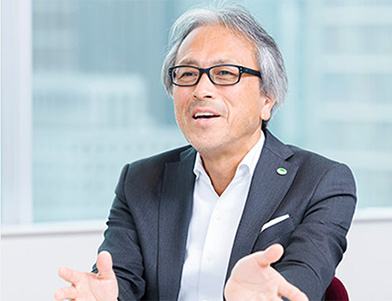
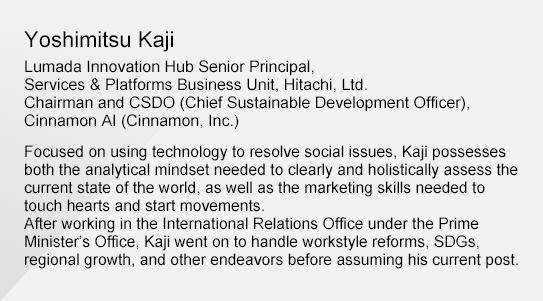
―Mr. Hosoya, you serve as the CLBO and COO (chief operating officer) of the Social Infrastructure Systems Business Unit. What is the Social Infrastructure Systems Business Unit’s role and mission in the context of Hitachi’s social innovation business?
Hosoya: The Social Infrastructure Systems Business Unit is responsible for many social infrastructure systems and is thus tasked with an important mission, namely the digital transformation of various types of social infrastructure.
For example, we have built and operated mission-critical systems and developed and maintained social infrastructure in a wide range of areas, such as federal and local governments, electric power, transportation, telecommunications, and defense.
Specific examples of these systems include a ticketing and reservation system for JR ticket counters; a supercomputer system for the Japan Meteorological Agency; public systems for federal and local governments; telecommunications systems; and systems that contribute to land, sea, air, and space defense.
In this way, the Social Infrastructure Systems Business Unit has been involved in social infrastructure for a long time and has built up strengths in various areas, including our engineering capability, OT (control and operational technologies) and IT expertise, human resources, and platform for co-creation with customers. Now we are leveraging these strengths to carry out the digital transformation of social infrastructure.
Sawa: Hitachi is a company that has developed many businesses and handles vast amounts of firsthand information gained from those businesses. At the same time, it is a company where each business is highly specific and thus tends to become isolated and remain within a single field. Put another way, it’s easy for each business to become siloed, so I think it’s really interesting for the keyword “Lumada” to pop up there.
According to global economist Joseph Schumpeter, innovation is not the innovation of technology, but rather the combination of technology in new ways. As a platform for creating new combinations, you could say that Lumada perfectly embodies this concept or spirit of innovation.
The assets Hitachi has in each business area are not simply legacy assets—they are invaluable assets that no other company can replicate. Combining these assets can bring forth a new chemical reaction, so to speak. I think this sense of immense potential is what gave rise to Lumada.
Hosoya: Exactly. Until a few decades ago, whether it be railway systems or power generation systems, each system consisted of individual, specialized equipment, but following the technological innovation of computers, we are now in an era where such systems can be composed of general-purpose equipment. This made it easier to connect IT to the information generated by systems, which in turn led to the birth of the OT×IT world.
For example, by using data from sensors installed on train cars, we can detect the deterioration of parts at an early stage and prevent train accidents before they occur. Then, if we apply AI analysis to the data about train parts, we have an even greater chance of identifying the potential deterioration of parts before a train accident occurs. Furthermore, if we know the warning signs of deterioration, we can verify the life expectancy of each part, helping to reduce both maintenance costs and the impact on the environment. In this way, through the combination of OT and IT, more and more new value is born. Positioned as a collection of solutions that accelerate digital innovation through co-creation with customers, Lumada aims to make this kind of world a reality.
Kaji: There are very few companies in the world that can actually connect OT and IT. Hitachi is one of those very few. The train cars, power plants, elevators, and other things that Hitachi has made up to now—these are connected via optimized control that uses both OT and IT digital technologies. In that sense, I think Lumada is a mechanism for creating a major new trend. In other words, it’s a movement.
Also, as Mr. Hosoya, Mr. Sawa, and I hinted at, Lumada includes elements and concepts that can be applied to many things. Because of that fuzziness, there is potential for Hitachi to scale out our social infrastructure business by incorporating various things.
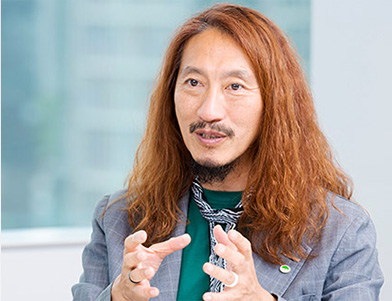
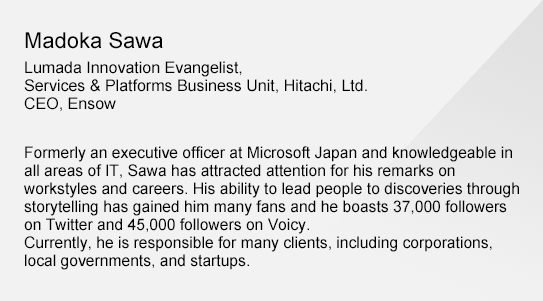
―Specifically, what approach are you taking with regard to the digital transformation of social infrastructure?
Hosoya: The permeation of IT throughout various different fields such as railway, energy, mobility, and buildings, leads to the innovation of social infrastructure. With its “Scale by Digital” concept, Hitachi hopes to spread digital transformation by combining OT with IT and by using Lumada in various areas (as shown in the figure). This approach is what Mr. Kaji was describing earlier: using digital technologies to scale our social infrastructure business.
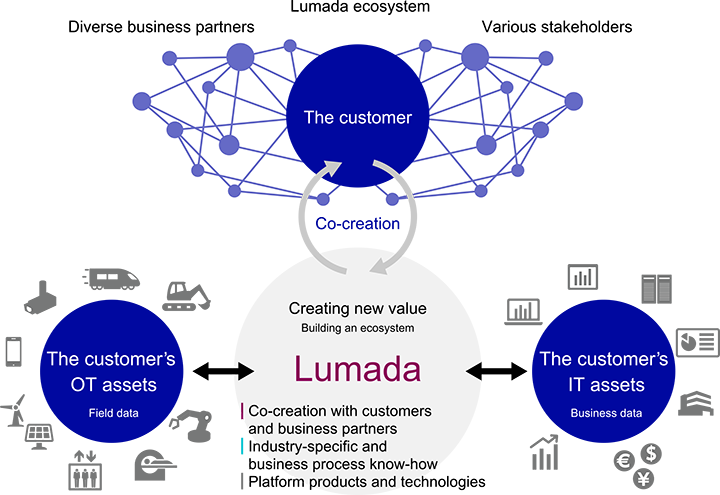
Figure: Conceptual overview of Hitachi’s “Scale by Digital” approach
Enhancing “Scale by Digital” by combining IT with OT
(control and operational technologies for railway, electric power, buildings, etc.)
to create new value in various fields
More concretely, in our businesses, we use OT to extract data and then use IT to analyze and visualize the data. That is then turned into a Lumada solution and used to generate new value through co-creation with customers.
In the past, Hitachi often ran its OT and IT businesses separately, and we went to great pains to finally link those businesses. So, the challenges that our customers face when they try to combine OT and IT are basically things that Hitachi has already been through. That’s why Hitachi is able to empathize with our customers and suggest the right solutions to their issues. Even when it comes to social issues that are hard for Hitachi to resolve by itself, we can boldly take on those issues.
Sawa: For most solutions to social issues, there is neither a precedent nor any one right answer. But by the same token, there are a lot of untried “weapons” that can be used to resolve those issues. I think it is important to pick up on this fact. “No one’s tried this combination yet. Why don’t we give it a shot? I think it might work.” If Hitachi’s middle management, the people working in the field, and all of our co-creation partners have this kind of mindset and entrepreneurial spirit, there isn’t much that we can’t do.
For example, let’s look at camping as an analogy. Fetching water, building a campfire, bringing cookware, cooking, driving—you need someone to carry out each of those roles. The more people you have to fulfill those roles, the more fun the camping experience will be, and you’ll be able to do difficult things that can’t be done alone. Hitachi differs from other companies in that we have lots of assets that carry out all those different roles and we have Lumada to organize those assets. If we can maximize that potential, I think we can survive even the most extreme camping situation. In other words, we can even resolve social issues.
Kaji: As issues become more complex and diverse, they also become harder for any one group to resolve. That’s why we need to join forces with lots of business partners to work on innovation. This idea laid the foundation for the Lumada Alliance Program.
To Hitachi, the establishment of the Lumada Alliance program was, in a sense, a historic turning point. Despite being a company of talented engineers gathered from around Japan, instead of clinging to self-sufficiency, Hitachi decided to create an amazing mechanism (the Lumada Alliance program) and build an ecosystem. This was a major decision for Hitachi and demonstrated Hitachi’s strong determination to actually carry out co-creation and, moreover, the Lumada concept in order to achieve a sustainable society.
Hosoya: Regarding the digital transformation of social infrastructure, we also need to have a sense of urgency. With so many issues that we can no longer afford to put off, it’s essential to engage in trial and error with our customers and business partners while also swiftly implementing our innovations in society. I want to move forward with that in mind.
